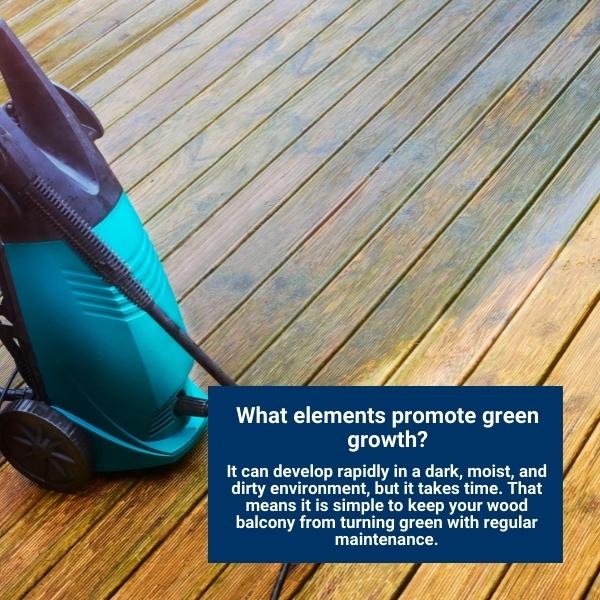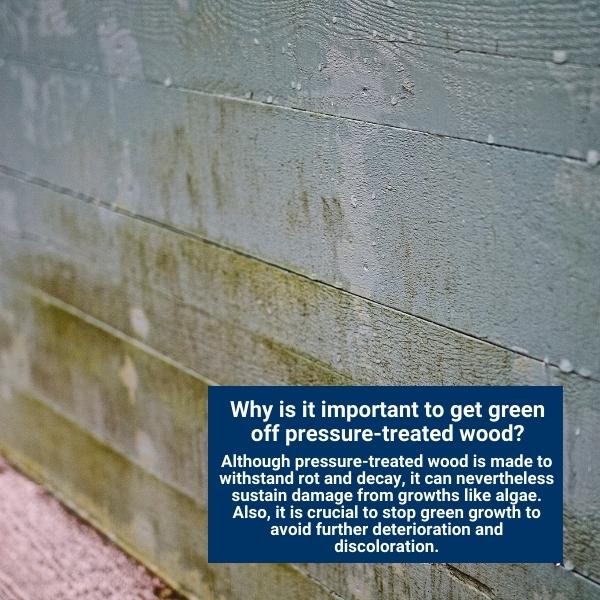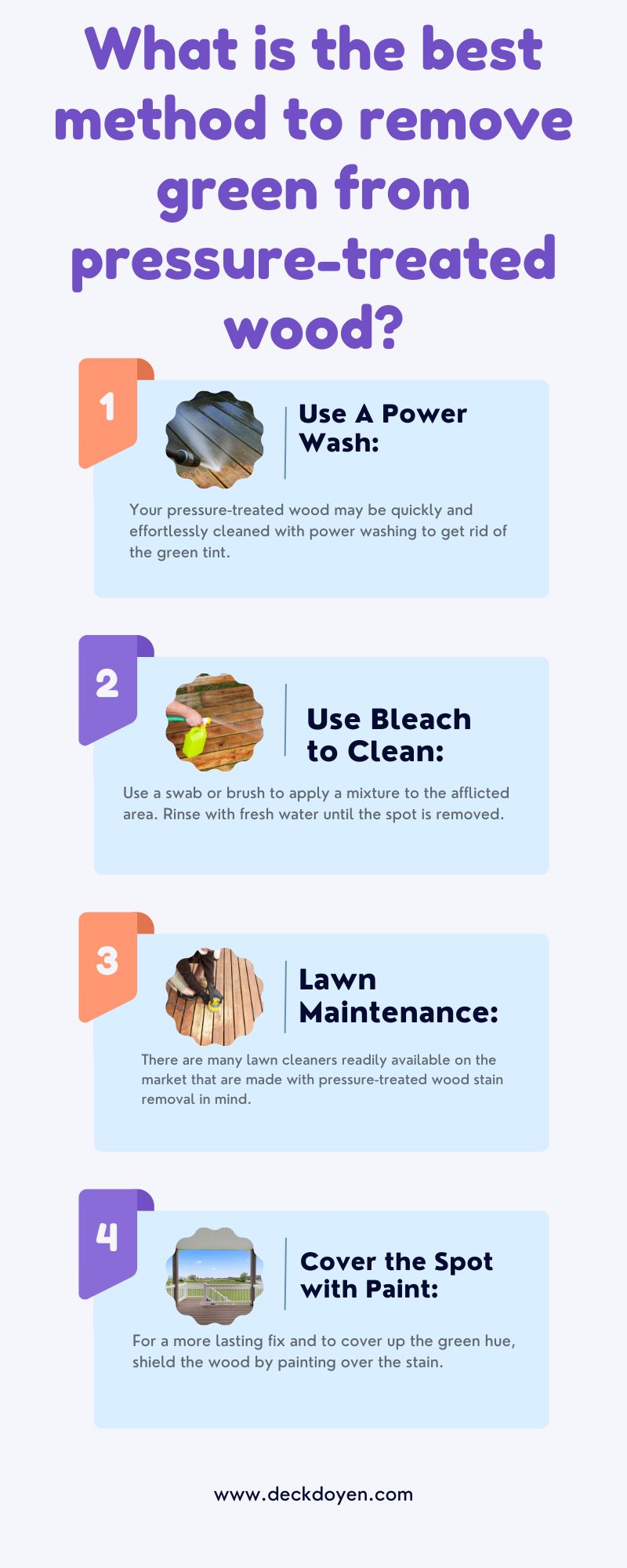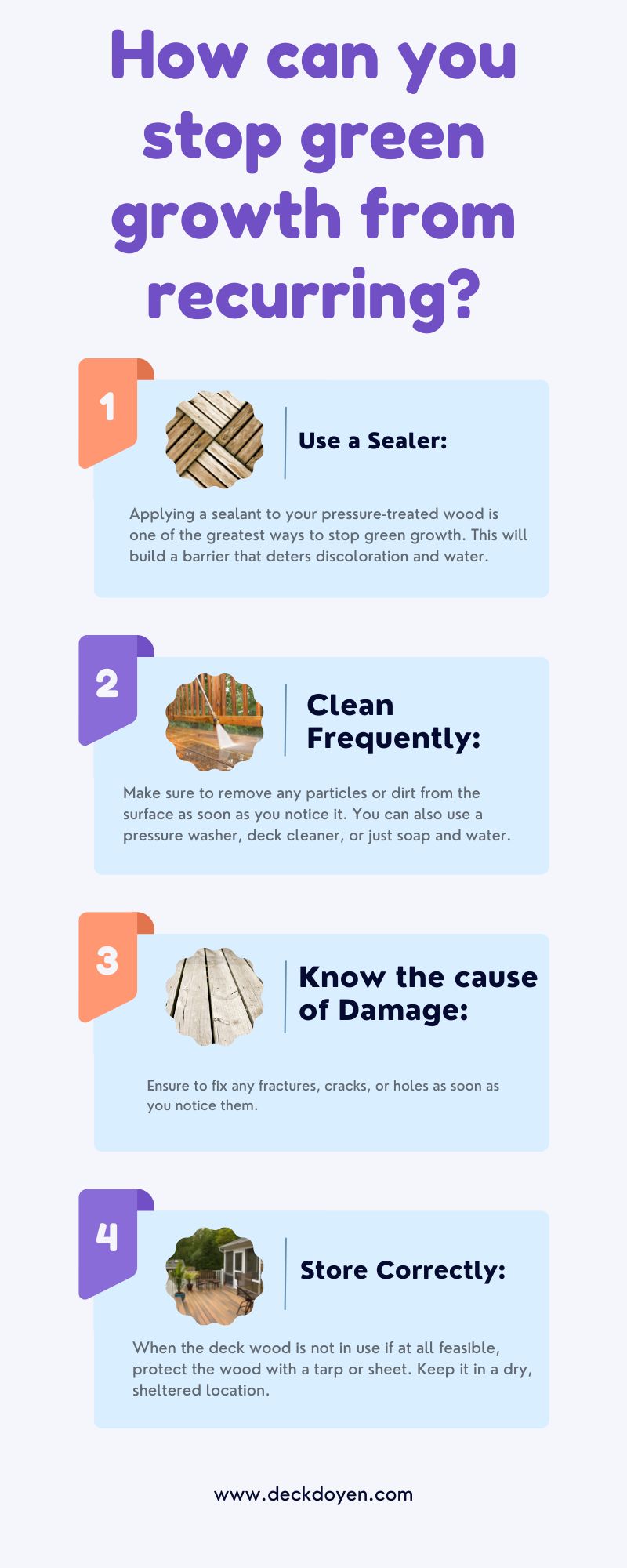You may have observed that if you have ever purchased something made of wood that is intended for outdoor use turns green. In addition to destroying the furniture’s aesthetic appeal, green threatens the wood. And if the green is not properly controlled, it will keep growing. So, the question arises about how to get green off pressure-treated wood.
The first step to getting green off pressure-treated wood is to identify the cause. The best environment for the development of green is one that lacks daylight and is moist, although this does not happen instantly. And it, in turn, leads to the conclusion that, with the right care, green development can be stopped.
In this blog post, I will discuss a few possible approaches to get the stain off the wood and restore it to its original appearance. I will also offer some advice on how to avoid being stained in the future. Read on for some useful ideas, whether you are trying to finish an existing job or are just beginning with pressure-treated wood.
How To Get Green Off Pressure-Treated Wood
Due to its affordability and durability, pressure-treated wood is a preferred material for both residential and commercial construction. Pressure treatment might leave behind such a greenish color that isn’t usually desired, but it does preserve the wood against decay and vermin.
Also Read: Can Deck Screws Be Used For Framing?
Green is challenging to get rid of since it grows back. They cannot be quickly and confidently erased, unlike stains caused by ink, liquor, etc. The green will continue to spread if it is not adequately handled. Additionally, it grows swiftly. Therefore, keep them under control unless you want green spots to appear throughout.

At first, you need to find the main cause of green growth and then remove it from pressure-treated wood using appropriate procedures and products. The favorable conditions for the development of green are moist places with no sunshine. But, the growth of green mold does not occur instantly, so when handled adequately, then it can be controlled effectively.
It is not a big deal if green invades your wood. Consequently, you will eventually need to handle it. Let’s learn about the numerous approaches that can be employed to eliminate it.
What Elements Promote Green Growth?
You can avoid the growth of green on your balcony, garden, and wooden outdoor furniture by being aware of the conditions that encourage it to flourish.
It can develop rapidly in a dark, moist environment, but it takes time. That means it is pretty simple to keep your wood balcony from turning green with regular maintenance. It would help if you concentrated on paying attention to two things: moisture and dirt.

Dirt:
The accumulation of needles, pinecones, and other waste on your deck prevent sunlight from penetrating the wood’s surface and provides the perfect environment for the growth of algae, mold, and fungus. Regularly wipe or blow away dirt from your balcony.
Shady Dark:
Sweeping may not be sufficient if plants or your house naturally shadows your roof. To prevent green and fungus from growing on your balcony, you must perform a thorough cleaning once a year.
Moisture:
Does your property have any locations where water collects and sits after a rainstorm? However, your boards may be sealed or uneven, and while most properties have enough area between them to allow for water drainage, this may not be the case with your balcony. Wipe snowfall off your deck during the winter to keep the area as dry as possible.
Also Read: Should A Deck Be Level Or Sloped? Detailed Answer!
Why Do You Need To Get Green Out Of Your Pressure-Treated Wood?
On any wood, algae and other sorts of green growth can be unattractive, but pressure-treated wood is especially vulnerable to them; therefore, it is crucial to get rid of them. Although pressure-treated wood is made to withstand rot and decay, it can nevertheless sustain damage from growths like algae. It can make the wood appear discolored and can attract moisture to the surface of the wood, which can cause damage.

Green is more difficult to remove than a typical stain since it can be hard to kill and will soon grow again if improper removal methods are used. However, by using the appropriate methods, you may get rid of green and stop it from returning.
The Best Method For Removing Green From Pressure-Treated Wood (Few Easy Methods)
Although ugly, green algae are a frequent issue with pressure-treated wood. The green is not hazardous; it can be challenging to get rid of and could mean that your wood is not adequately coated.
Here you will get to know a few different techniques for getting rid of the green tint on pressure-treated wood, restoring the wood to its original appearance and avoiding it in the future:
- Use A Power Washer: Your pressure-treated wood may be quickly and effortlessly cleaned with the power washing to get rid of the green tint. Direct the power washer at the stain, sit back, and watch it work. To eliminate the stain, you might be required to scrub the area several times.
- Use Bleach To Clean: You might try cleaning the stain with bleach if power washing is not a possibility. Use a swab or brush to apply a mixture of one part bleach to four parts of water on the afflicted area. Rinse with fresh water after scrubbing the spot until the spot is removed.

- Clean Your Lawn: Many lawn cleaners readily available on the market are made with pressure-treated wood stain removal in mind. Use a swab or brush to apply the cleaner to the stain as directed on the product’s label. Rinse with fresh water after scrubbing the spot until the discoloration is removed.
- Cover The Spot With Paint: Try painting over the stain if you are searching for a more lasting fix. This will help shield the wood from additional stains in addition to covering up the green hue. Use a paintbrush or roller to apply paint in a shade that closely resembles the wood’s original tone. Before using the surface, let the paint fully cure.
- Products For Removing Green Algae And Fungus: For the purpose of removing the fungus and green algae from pressure-treated wood, a wide variety of treatments are available in the marketplace. Be sure to carefully read the instructions and test each product on a small patch of wood before use to ensure that it won’t damage the wood’s surface.
- The Outdoor Cleaner in 30 Seconds.
- Cleaner, such as Simple Green All-Purpose.
- Olympic Premium Deck Washer.
- Sunnyside 2-Minute Algae Cleaner.
- Hydrogen Peroxide: Hydrogen peroxide is a different cleaning agent that you most likely already have at home. A 1:1 mixture of this and water can be used to get rid of the green tint on your pressure-treated wood. With a sponge or brush, pour the solution into the stain, then scrape it until it disappears. When you’re done, wash with fresh water.
Also Read: Can You Build A Deck Over An AC Unit? – Step By Step Guide
- White Distilled Vinegar: White vinegar is a well-liked natural cleanser for indoor and outdoor surfaces. One gallon of water and one glass of white vinegar can be combined to create the solution, which should then be used to scrub the deck until all green algae, mold, and fungus are removed.
How To Get Green Algae Off Of Wood That’s Been Pressure Treated?
There are numerous different approaches to removing green algae from pressure-treated wood in addition to the ones mentioned above. Some approaches are more efficient than others, and some will be more appropriate for your particular circumstance. Try out a handful of these strategies to determine which one suits you the best.
Other options include a brush, a power jet, or a chemical cleaning.
Power Jet:
A power jet is a device that cleans surfaces by applying high pressure to water. A power jet is available for purchase or rental, and there are several sizes for various purposes. It would be best if you put soap in the power jet before you can use it. You can use light, soapy water or one of the dedicated power jet soaps. Additionally, you must put on safety gear like gloves and goggles.
When you have all you need, take these actions:
- Set up the power jet following the directions provided by the manufacturer.
- Spray low-pressure water on the pressure-treated wood’s surface.
- Spray the wood with soap.
- Start washing the wood while increasing the pressure.
- As you move across the surface of the wood, swing the pressure washer back and forth.
- Use water with low pressure to rinse the soap away.
- Allow the wood to dry.

Brush:
If you don’t want to use a power jet, you can use a brush to get rid of the algae on pressure-treated wood. A hard brush, like a stiff brush or scrub brush, is required. Additionally, gloves and safety glasses are required.
Also Read: Can You Build A Deck Over A Septic Tank? Step By Step Guide
These are the steps to utilize a brush:
- Spray water on the pressure-treated wood’s surface.
- Wash the wood with soap.
- Use a brush to scrub the wood to get rid of the green.
- To remove the soap, wash with water.
- Let the wood dry.
Chemical Cleanser:
Green can also be eliminated from pressure-treated wood using chemical cleaning. To pick a cleaner suitable for pressure-treated wood, carefully read the labels of the many varieties of available cleaners. When utilizing a chemical cleaner, gloves and protective goggles are also recommended.
In order to utilize a chemical cleaning, take these actions:
- Mist water on the surface of the pressure-treated wood.
- Spray the wood with the cleaner.
- Scrub the wood with a brush to remove the green.
- Rinse the cleanser with water.
- Permit the wood to dry.
Keeping Green Off From Recurring
Use these helpful hints to assist with green prevention in the future.
Use A Sealer:
Applying a sealant to your pressure-treated wood is one of the greatest ways to stop green growth. This will build a barrier that deters discoloration and water. For the best results, select a sealer that is specially made for pressure-treated wood and adhere to the directions on the packaging.

Clean Frequently:
To avoid green, it is critical to regularly clean pressure-treated wood. Make sure to remove any particles or dirt from the surface as soon as you notice it. You can use a pressure washer, deck cleaner, or just soap and water to maintain the area clean. — Combine a little soap and water and scrub the surface of your pressure-treated wood with a sponge or brush to clean it. Be sure to thoroughly dry the area after rinsing it with clean water and then use it.
Also Read: Deck Nail Vs Screw, Which Is The Best? When And Where To Use It?
Investigate For Damage:
Regularly check your pressure-treated wood for any indications of damage. Make sure to fix any fractures, cracks, or holes as soon as you notice them. This will lessen the likelihood of water and stains damaging the wood by penetrating it.
Store Correctly:
Ensure that you keep your pressure-treated wood in a dry, sheltered location while not in use. It will be less likely to get soiled or damaged as a result of this. Protect the wood with a tarp or sheet when it is not in use.
Conclusion
The right techniques can be applied to eliminate the green. Making sure a particular pesticide is suitable for the specific wood that has been infested with green, however, is even more important. A well-ventilated space is also necessary when dealing with chemicals like bleach and peroxides. In conclusion, be sure that green does not bloom everywhere. And if they do, then sadly, go ahead and take these simple precautions stated above.
Also Read: Deck vs Interlock: Which One To Use And Where?
FAQs
Is Green Mold On Pressure-Treated Wood Dangerous?
Molds, whether they are green, black, or another hue, can be harmful to your health, especially if you already have a weak immune system. Mold can affect the respiratory system, leading to allergic reactions and asthma attacks. Green mold must therefore be removed as soon as it is discovered.
Can Green Algae Be Painted Over On Pressure-Treated Wood?
Although painting pressure-treated wood will conceal the green and improve its appearance, it won’t get rid of the pollution at the source. This means that the wood underneath will continue to be affected; within weeks, green algae will begin to grow on your wood.

